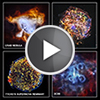CXC Home | Search | Help | Image Use Policy | Latest Images | Privacy | Accessibility | Glossary | Q&A
X-ray Vision Reveals the Insides of Stars
Quicktime MPEG With closed-captions (at YouTube)
You might have heard that much of the material making up the world around us was forged in the hot bellies of massive stars. But how do we know this? We can't send probes to investigate because there isn't a material on Earth that can withstand the immense heat inside a star without being vapourised. Luckily for us (but not for the stars), every star over 8 times heavier than our Sun will eventually explode as a supernova. When this happens, all the star's innards are launched into space for everyone to see. A supernova explosion also makes rare elements like Gold, Titanium and Uranium and can briefly outshine an entire galaxy! Each of these four fabulous photographs shows the remains of an exploded star - called a supernova remnant. The pictures were released by NASA's Chandra X-ray Observatory to celebrate the telescope's 15th birthday. Chandra is a telescope that is specially designed to look at X-rays that come from very hot places and objects in the Universe - including exploded stars. Because the explosions have super-heated these stellar wreckages, they glow very brightly in X-ray light. Since the Earth's atmosphere blocks X-rays from space, Chandra has to orbit high above it. It currently looks at the Universe up to an altitude of 140,000 km above the Earth. From this ideal position Chandra can create X-ray pictures with superb detail, allowing us to study the shape, movement and chemical make-up of supernova remnants. Moving from left to right, the objects are The Crab Nebula, G292.0+1.8, Tycho's Supernova and on the bottom is 3C58.
[Runtime: 02:38]
Quicktime MPEG With closed-captions (at YouTube)
You might have heard that much of the material making up the world around us was forged in the hot bellies of massive stars. But how do we know this? We can't send probes to investigate because there isn't a material on Earth that can withstand the immense heat inside a star without being vapourised. Luckily for us (but not for the stars), every star over 8 times heavier than our Sun will eventually explode as a supernova. When this happens, all the star's innards are launched into space for everyone to see. A supernova explosion also makes rare elements like Gold, Titanium and Uranium and can briefly outshine an entire galaxy! Each of these four fabulous photographs shows the remains of an exploded star - called a supernova remnant. The pictures were released by NASA's Chandra X-ray Observatory to celebrate the telescope's 15th birthday. Chandra is a telescope that is specially designed to look at X-rays that come from very hot places and objects in the Universe - including exploded stars. Because the explosions have super-heated these stellar wreckages, they glow very brightly in X-ray light. Since the Earth's atmosphere blocks X-rays from space, Chandra has to orbit high above it. It currently looks at the Universe up to an altitude of 140,000 km above the Earth. From this ideal position Chandra can create X-ray pictures with superb detail, allowing us to study the shape, movement and chemical make-up of supernova remnants. Moving from left to right, the objects are The Crab Nebula, G292.0+1.8, Tycho's Supernova and on the bottom is 3C58.
[Runtime: 02:38]
(Credit: NASA/CXC/A. Hobart)
A Tour of The Big, Bad & Beautiful Universe with Chandra
Quicktime MPEG With closed-captions (at YouTube)
In fifteen years of operation, the Chandra X-ray Observatory has given us a view of the universe that is largely hidden from telescopes sensitive only to visible light.
Chandra has captured galaxy clusters - the largest gravitationally bound objects in the universe - in the process of forming, and provided the best evidence yet that the cosmos is dominated by a mysterious substance called dark matter.
Chandra has observed gas circling near a black hole's event horizon. The atoms of this gas are doomed to destruction by the extreme gravity of the black hole.
Most of the elements necessary for life are forged inside stars and blasted into interstellar space by supernovas. Chandra has tracked these elements with unprecedented accuracy.
Young stars are crackling with X-ray flares and other energetic radiation. By monitoring clusters of young stars, Chandra can give us a sense of what our young Sun was like when life was evolving on Earth.
Chandra: Taking us on a unique voyage into the big, bad and beautiful universe.
[Runtime: 02:01]
Quicktime MPEG With closed-captions (at YouTube)
In fifteen years of operation, the Chandra X-ray Observatory has given us a view of the universe that is largely hidden from telescopes sensitive only to visible light.
Chandra has captured galaxy clusters - the largest gravitationally bound objects in the universe - in the process of forming, and provided the best evidence yet that the cosmos is dominated by a mysterious substance called dark matter.
Chandra has observed gas circling near a black hole's event horizon. The atoms of this gas are doomed to destruction by the extreme gravity of the black hole.
Most of the elements necessary for life are forged inside stars and blasted into interstellar space by supernovas. Chandra has tracked these elements with unprecedented accuracy.
Young stars are crackling with X-ray flares and other energetic radiation. By monitoring clusters of young stars, Chandra can give us a sense of what our young Sun was like when life was evolving on Earth.
Chandra: Taking us on a unique voyage into the big, bad and beautiful universe.
[Runtime: 02:01]
(Credit: NASA/CXC. Produced by A.Hobart (CXC), Directed by K.Arcand (CXC), Script by W.Tucker (CXC), Narration by Chris Camilleri; )
NASA's Chandra X-ray Observatory Celebrates 15th Anniversary
Quicktime MPEG With closed-captions (at YouTube)
To celebrate the 15th anniversary of NASA's Chandra X-ray Observatory, we have released four new images of supernova remnants. These show Chandra's ability to study the remains of supernova explosions, using images that are the sharpest available in X-ray astronomy. The images of the Tycho and G292.0+1.8 supernova remnants show how Chandra can trace the expanding debris of an exploded star. The images show shock waves, similar to sonic booms from a supersonic plane, that travel through space at speeds of millions of miles per hour. The images of the Crab Nebula and 3C58 show the effects of very dense, rapidly spinning neutron stars created when a massive star explodes. These neutron stars can create clouds of high-energy particles that glow brightly in X-rays. The image for G292 shows oxygen (yellow and orange), and other elements such as magnesium (green) and silicon and sulfur (blue) that were forged in the star before it exploded. For the other images, the lower energy X-rays are shown in red and green and the highest energy X-rays are shown in blue.
[Runtime: 01:42]
Quicktime MPEG With closed-captions (at YouTube)
To celebrate the 15th anniversary of NASA's Chandra X-ray Observatory, we have released four new images of supernova remnants. These show Chandra's ability to study the remains of supernova explosions, using images that are the sharpest available in X-ray astronomy. The images of the Tycho and G292.0+1.8 supernova remnants show how Chandra can trace the expanding debris of an exploded star. The images show shock waves, similar to sonic booms from a supersonic plane, that travel through space at speeds of millions of miles per hour. The images of the Crab Nebula and 3C58 show the effects of very dense, rapidly spinning neutron stars created when a massive star explodes. These neutron stars can create clouds of high-energy particles that glow brightly in X-rays. The image for G292 shows oxygen (yellow and orange), and other elements such as magnesium (green) and silicon and sulfur (blue) that were forged in the star before it exploded. For the other images, the lower energy X-rays are shown in red and green and the highest energy X-rays are shown in blue.
[Runtime: 01:42]
(Credit: NASA/CXC/A. Hobart)
Return to 15year (July 22, 2014)





